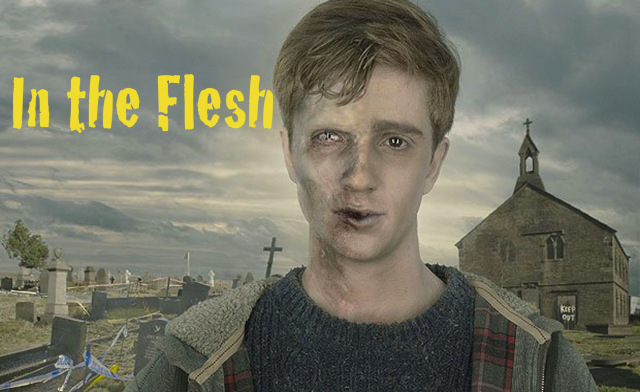Must-See BBC TV: In the Flesh
With so many zombie-themed movies, TV shows and video games on the market these days, it's hard to find a zombie story that's genuinely unique. Most follow the apocalyptic bloodbath plot that was pioneered by George Romero in his zombie films. In contrast, the BBC has broadcast In the Flesh, a three-part miniseries that has roots in Romero's work but takes it into provocative new territory.
Created and written by Dominic Mitchell, In the Flesh is about a British teenager named Kieren (Luke Newberry) who is being treated for "Partially Deceased Syndrome", or PDS. PDS is the term given to the phenomenon that reanimated the dead in a zombie outbreak that happened four years earlier. In the time since then, a large number of zombies--or "rotters" as they are called in the miniseries--have been rehabilitated through medical treatments and are being integrated back into society. The series follows Kieren as he returns to his family in the rural village of Roarton and how he and the world around him are adjusting to existence of the partially dead among the living.
While there are some brief flashes of gore in In the Flesh, it is not your typical zombie story. It takes the imagery, concepts and symbolism associated with zombies and uses them to examine modern issues such as drug abuse, mental health, Post-Traumatic Stress Disorder (PTSD), and widely-publicized diseases such as cancer and AIDS. In the series' post-outbreak world, PDS sufferers receive daily injections of a medication called Neurotriptyline and therapy to help them move on with their (after)lives, while family members of PDS sufferers can attend support groups to discuss the difficulties of caring for loved ones who are neither completely alive nor dead. Government-published posters and literature about PDS make cameo appearances throughout the series, while some survivors of the zombie outbreak are appalled at having to accept PDS sufferers--including ones they knew and cared for before the outbreak--as equal members of their community. In a sense, In the Flesh is the equal but opposite of Bob Clark's Deathdream (1972).
The plot device of rehabilitating zombies has been played for laughs many times before, such as in Shaun of the Dead, Fido, Ugly Americans and Warm Bodies. Yet In the Flesh plays it mostly straight and it works, largely due to Mitchell populating his story with so many interesting ideas, vivid details and nuanced characters. Monsters have been used as metaphors for diseases and social problems many, many times before, but it's rare to see a story like In the Flesh that takes the perspective of people who have to care for loved ones who have become "monsters" and how the newly monster-ized cope with their not-quite-human status. (For another good example of this, see my essay on the original The Fly and its sequels.) Between the strength of the script and wonderful performances by the cast, this series succeeds as a horror drama, a rare accomplishment in horror television. My only complaint is that the series runs for just three hour-long episodes; Mitchell provides so many details and subplots within his story that I'd love to see where it goes next after the third episode comes to an end.
If you're looking for hordes of zombies having a blood-drenched, entrails-splattered feeding frenzy on the living, this miniseries is not for you. Yet if you're looking for a unique, rewarding and thoughtful story about the living dead, In the Flesh is something you need to see. With the topics such as mental health, PTSD and suicide making frequent appearances in current discussions over gun violence and veterans returning from extended tours in the Middle East, In the Flesh really is a zombie tale for our time.
For more details about In the Flesh, including an annotated shooting script for the "Understanding PDS" public service video, check out the official series page over at the BBC site.




Comments
Post a Comment